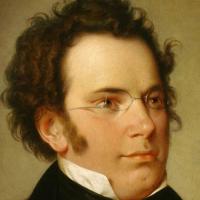Schubert began thirteen symphonies, of which he left six unfinished. Most of these fragments are in piano score only. But for the symphony in B minor, a work we have come to know as the Unfinished Symphony (No. 7 or 8, depending on the system of counting, dated October 1822), he completed the first two movements and began sketching out and partly orchestrating the third before putting it aside. (A new six-page document, apparently containing further orchestration of the third movement,was found earlier this year.)
It remains a mystery why Schubert did not continue work on a composition that was so far advanced and in which he had finally found a truly individual symphonic voice. Much speculation exists about the reasons.
In the summer of 1822 Schubert began to suffer the first symptoms of syphilis and some think he associated the symphony he was working on with the realisation that his illness would sooner or later lead to his death, and therefore abandoned it. Others believe that he ran into musical problems because of the symphony’s unusual key of B minor, particularly difficult for period brass instruments, or the fact that both existing movements were in a similar tempo and used triple metre, as indeed did the third.
Another line of argument rests on the fact that Schubert was in awe of Beethoven: his intensive engagement with the latter’s symphonies might have led him to doubt whether he could finish his symphony in the same ambitious scope with which he had started it. By contrast, Schubert experts George Grove and, more recently, Brian Newbould have competently argued that Schubert’s Entr’acte for the play Rosamunde, also in B minor and with identical instrumentation to the symphony, was in fact conceived as the fourth movement and taken out of context for commercial reasons. None of these theories is completely satisfactory, and some are based on speculation and doubtful information.
Research has brought to light that a number of entries on the autograph score, including the date, are in someone else’s hand, and that Schubert’s letter dedicating the symphony to the Musical Society of Styria is inauthentic. For over forty years the score was in the care of the brothers Joseph and Anselm Hüttenbrenner, who held on to it without making it public. It was not until April 1865 that the conductor Johann Herbeck, having heard about the existence of such a score from Joseph Hüttenbrenner, approached the elderly brother Anselm who did not hesitate to give him the original and grant him permission to perform the work.
The symphony was premiered in Vienna in December 1865 to great acclaim. Herbeck complemented the two complete movements of the symphony in B minor with the rousing finale of Schubert’s third symphony in D. But from its second performance in November 1866 onwards it became
customary to present the Unfinished Symphony in its two-movement form. Its popularity proves that this truncated symphony, dense with emotional
content, complex and full of surprises, provides a musical journey which is fully satisfying in itself.
Allegro moderato
The first movement in B minor is characterised by harsh contrasts in dynamics and mood. From the pianissimo opening in the cellos and basses it establishes a dark colour of sound. The first melancholic theme enters over nervous strings. An abrupt transition to the second subject is characteristic of Schubert’s stunning use of a long held single note or fortissimo chords to create tension before its release with a lyrical melody that suddenly transports us into the light. But in the middle of the beautiful, singable second subject, based on an old folk tune, there is another sudden outburst of violence.
This interplay between lyricism and drama, calmness and turbulence, light and darkness pervades the whole of the first movement, unprecedented in its exposition of extreme contrasts. Beauty is never far from being violently disrupted. Timpani and, unusually, three trombones (as in the Mass in E flat) emphasise the dramatic moments. Repetitions and imitations are used
to great effect. Previously hushed themes come back thundering, leading to shattering climaxes before a final section that ends on dramatic chords. A wealth of surprising harmonic developments makes this movement a superb example of Schubert’s mature symphonic voice.
Allegro con moto
The second movement in E major contrasts with the dark mood of the first. It evokes light, beauty and peace with a calm opening phrase played by strings and woodwind, complemented by a simple ascending figure in the horns, while the basses play a descending pizzicato motif. Such subtle mirror effects and dialogues between single or groups of instruments shape the whole movement. Its specific colour derives from Schubert’s unique harmonic device of freely shifting between major and minor modes, creating ambiguities and oscillating moods.
Another striking feature of the Allegro is Schubert’s poignant use of silences. Unlike the dramatic, abrupt transitions heard earlier, the themes in the second movement seem simply to die away. The music almost comes to a halt, before a four-note motif in the violins tentatively brings out a new subject or leads to a new key. The second subject is lyrical as well, and like the first one is
interrupted again and again by a weighty subject. A growing competition between the placid and the forceful theme leads to the movement’s only moment of real passion. The coda brings back the first subject, opening it out before slowly and calmly fading away, chords ascending to its final resolution.
© Sabine Köllmann
Composer: Schubert Wiki Link: https://en.wikipedia.org/wiki/Symphony_No._8_(Schubert) Title of Musical Work: Symphony No. 8 in B minor ‘Unfinished’, D759
